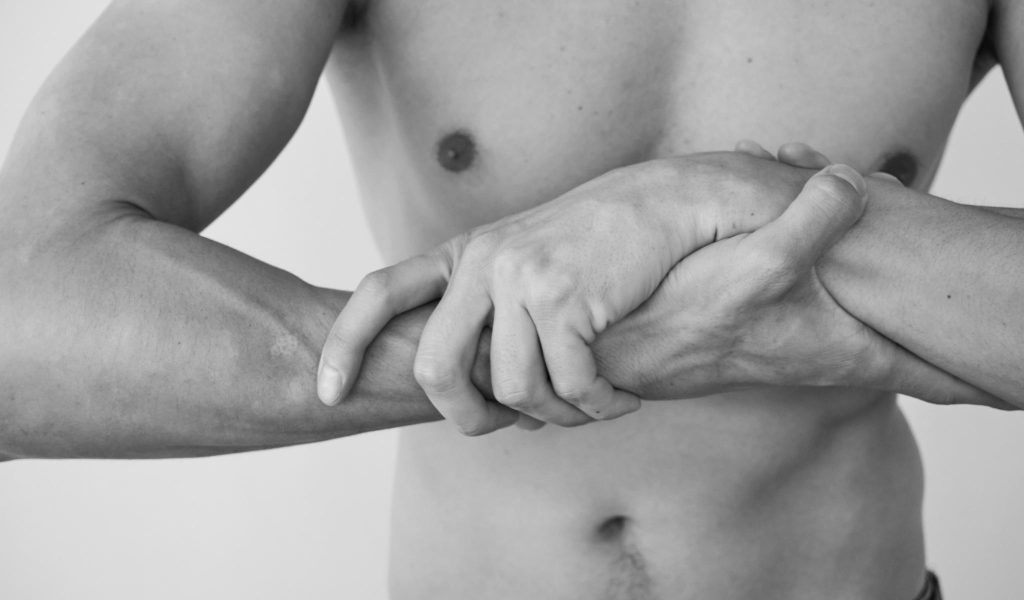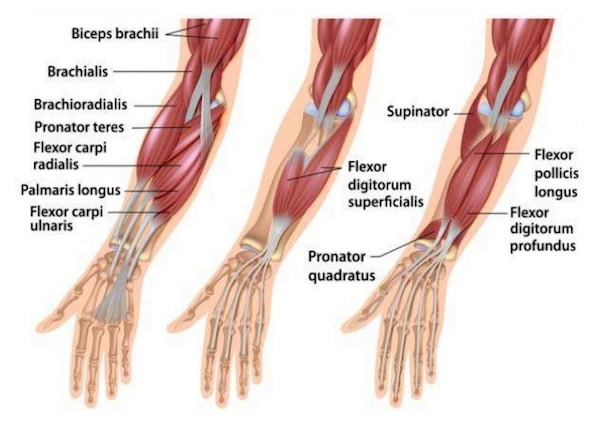No products in the cart.
The “Secret” to Big Forearms Revealed

When compared to the rest of the arm, the forearm muscles seem fairly unimportant.
The arm is split into the upper arm (consisting of the Biceps Brachii, Triceps, and Brachialis muscles) whilst the forearm is made up of the Brachioradialis and two groups of muscles known as flexors and extensors.
If you’ve ever seen a guy with massive forearms you’ll understand that these muscles are one of the first things you’ll see when looking at him.
So while training biceps and triceps are still very important. You should spare some time to work those forearm muscles. It will be well worth the effort.[toc]
Anatomy of the Forearm

The forearm muscle group is made up of many small muscles. The main muscle of the forearm is the Brachioradialis.
When training, a lot of effort is put into increasing the biceps brachii and triceps brachii. Less effort is placed on the Brachialis muscles and even less is placed on the Brachioradialis.
If you want bigger forearms though, you need to start finding exercises that will strengthen these two muscles.
How to Train Your Forearms
When it comes to training arms, you should prioritise the muscles by how much size they contribute. There is no point dedicating 3 sets to your Extensor Digitorum muscle as even if you could increase its size – who would notice?
The triceps are the biggest muscles in the arm. So these should be the most trained muscles, closely followed by the biceps.
After that, you can dedicate a bit of time to the Brachialis, and the Brachioradialis.
Your best bet is to find exercises that work more than one muscle group at a time.
Reverse barbell curls are a great exercise because not only do they work the Biceps, but they also work the Brachialis and Brachioradialis muscles.
When you are designing your program try not to ignore the small muscles of your arms. Also, don’t make the mistake of dedicating lots of sets on isolating them.
The forearms are made up of mostly Type I muscle fibres meaning that they require high rep sets to get fully worked.
You can also add in some low rep heavy weight exercises because all muscles respond well to a mix of rep ranges.
Now a lot of the exercises that are going to be mentioned involve isometric holds. This means exercises such as Farmer’s walks, Barbell holds, Deadlifts, Shrugs etc…
These are excellent for improving grip strength but are not enough for hypertrophy. So next we will look at a mix of different exercises so that your forearms have every chance of growing massively.
Top Exercises for Bigger Forearms
The first few exercises we are going to look at only work the forearms indirectly, but nevertheless, are crucial for growth.
Pretty much any exercise that involves pulling a heavy weight is going to help strengthen your forearms.
Deadlifting 240kg requires your forearms to isometrically hold the bar throughout. As do rack pulls, which are modified deadlifts that allow you to lift a heavier weight.
Another exercise that is great for wrist strength are shrugs (either barbell, dumbbell or plate). Holding a bar that contains a heavy weight and keeping it steady whilst you shrug upwards will really help your forearms.
Farmers walks, which are an exercise where you hold a heavy weight in both hands whilst walking, are one of the most underrated gym exercises out there. They help strengthen your forearms, your traps, and your core muscles.

If you’ve ever carried heavy shopping bags for longer than a mile you will be aware of how much this can movement can tax your forearms.
Other exercises that are more forearm specific. For example, the reverse barbell bicep curl and hammer curls are excellent. This is because they not only work your forearms but also your Biceps and Brachialis muscles.
The trick with both of these exercises is to perform the eccentric part of the movement (lowering the weight back down) very slowly. This is where the forearms are most active, so don’t rush past it!
Other Secrets to Bigger Forearms
Another way to increase forearm involvement in an exercise is to increase the circumference of the bar or handle.
For example, using a wider bar for bicep curls will force your hands to grip harder and therefore increase forearm activity.
Some gyms will have wider bars. If they don’t you should consider a product such as Fat Gripz.
These are mini handles that you can temporarily attach to bars, dumbbells, or cable attachments to increase the circumference.
Fat Gripz are excellent for turning barbell curls or shrugs into more forearm-based exercises.
Be careful with which exercises you use them for though. Bench pressing and shoulder pressing are not designed for Fat Gripz.
Anything that increases your grip strength runs the risk of lowering your stability. An exercise that involves a heavy weight hanging over your head or neck is not one that you should be compromising!
You can also use hand exercisers, which do work but tend to make you look like an uptight boss in a 90s sitcom. They will help with grip strength, and may lead to slightly bigger forearms but overdoing it will impact on your future training.
If your forearms are fatigued from 500 reps of a hand exerciser then your bench press the next day may not be all that it could be.
By all means, use them, but schedule them into your program rather than just adding them in whenever you fancy it!
